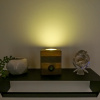Our newest product info video features yours truly explaining the basics of ultrasonic range-finding sensors. If you ever want to add distance sensing, or object/motion detection to your project, these sonar sensors are a great option. They're ultra-easy to use, with an analog output (among a couple other output options), you can get one distance-finding in no time. On top of their ease-of-use, I really like the flexibility of these sensors. You can implement them in both 3.3V and 5V systems (they operate from 2.5-5.5V), and the three different output options mean you can almost always find a pin for them on your microcontroller.
If you want to build a digital tape measure of your own, you can start with this Arduino sketch, and then pick up a Serial 7-Segment Display and ultrasonic sensor of your liking.
We get all of our range finders from MaxBotix, and they're available in two series – XL and LV. The XL sensors are fairly new and are described as 'super high performance'. In comparison to their LV counterpart, the XL rangefinders emit a higher-power sonar wave (which affords them an extra 4 feet of sensing range), are less susceptible to noise, and they feature real-time, automatic calibration.
Both series feature six different sensors: EZ0, EZ1, EZ2, EZ3, EZ4 and the WR1. Each EZ# sensor has a progressively narrower beam; the lower the identifying number the wider the beam. The more sensitive EZ0 is well-suited for object detection in a wide-open area, while the EZ4 is better-off being used for very directional sensing, or in more cluttered spaces. And then there's the wicked, rocket engine-looking WR1, which has a very precise, narrow beam. The WR1 is ruggedized and designed with outdoor environment usage in mind.
Ultrasonic distance sensors have seemingly endless uses. My college senior design team created an electric water fountain controlled via eight ultrasonic sensors. Others have used them as a part of a flame-throwing trampoline, or a trick-or-treater detecting jack-o-lantern.
Interested in learning more about distance sensing?
Learn all about the different technologies distance sensors use and which products would work best for your next project.
Take me there!







any ideas for an enclosure for the sensor and one for the display and arduino? maybe a colored lense for the display?
Are any of these devices suitable for use in a moist environment? Also, does ambient temperature affect the output?
I'm looking for a way to sense the water level in a outdoors water tank that's about 7ft high and 7ft in diameter.
Great video! I'd love a tutorial on creating that 3x3 led cube running in the background
Maybe they can do 25 feet to detect a solid wall. In my experience detecting smaller objects like a person or an arm or a chair you can depend on 6 feet, maybe 8. That's with the original narrow beam unit. Not accurate enough for a digital tape measure (unless you are ok with +- an inch or two). But great little units, very easy to use and very tough--I've remounted and resoldered mine into several projects.
Nice video, I like the demo of the tapemeasure!
On the other hand i would like to know a bit more about the frequency. was it 42kHz? is animals affected by the beam?
25 feet is quite some distance, can photodiodes be competitive on this distance?
Great video, thanks for that!
Has anyone ever told you that you look like Sheldon Cooper?
(Hope you don't take offense, that was meant as a compliment!) =D
Kudos to Jim, that was a very informative video(BTW, your workspace is a lot cleaner than mine is).